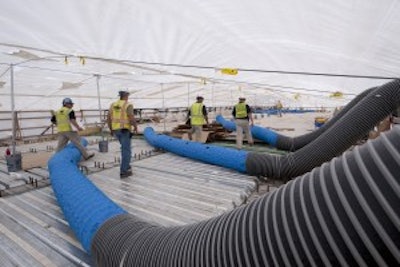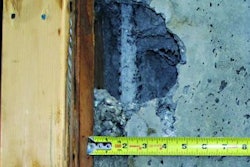
The Challenge:
Maintain a set temperature in four girders on the New Pearl Harbor Memorial Bridge in New Haven, Conn., to control structural steel movement and prevent the pier caps from cracking.
The Players:
Cianbro/Middlesex JVIII (CMJVIII)
Polygon
Munters
Hippwrap
The Process:
The Pearl Harbor Memorial Bridge is a 10-lane bridge that will be one of the first extradosed cable stayed bridges constructed in the U.S. An extradosed bridge is a hybrid design combining a concrete cable stressed girder bridge with a cable stayed bridge. The project involved the placement of two integrated pier caps encasing four girders spanning 230 feet over a roadway. These pier caps lock the girders into the concrete, restricting movement.
"Structural steel will elongate or contract with changes in temperature. And in our case, if this movement is not controlled while the concrete is curing, the pier caps will crack," said Aric Dreher, P.E., Superintendent with CMJVIII. "To minimize these movements, we had to put together a plan to maintain a set temperature range in each of the four girders. We had to hold these conditions before, during and after placement for an estimated period of 72 hours." In addition, the state limited the allowable movement of the steel beams to 2.5 millimeters. It was also required to maintain the steel temperatures at a range of 60 to 70 degrees Fahrenheit. CMJVIII contacted Richard Shoemaker, key account manager with Polygon. CMJVIII and Shoemaker then subcontracted Munters to handle the temperature control portion of the project. The Polygon team reviewed weather data to identify the climate control equipment needed. Polygon and CMJVIII spent eight weeks formulating an extensive work plan before submitting it to the bridge designer and state transportation officials for approval.
CMJVIII also hired Hippwrap, a company specializing in shrink wrap abatement containment, to design a shrink-wrap system to encase the 230-foot bridge span.
Polygon, Hippwrap, and Cianbro/Middlesex met on site frequently to discuss the myriad of details to ensure everyone was in synch.
Polygon recommended use of eight 30-ton DX cooling units and two 20-ton DX cooling units to hold the steel beams at 65 degrees for the allotted time and the company's ExactAire remote monitoring system to measure conditions on an ongoing basis.
The five DX units were placed on both sides of the temporarily closed highway below the bridge and ducted into the containment. The 30-ton DX units pumped cold air into the bottom of the bridge, and the DX 20-ton units supplied cold air to the top and undersides of the bridge. A measuring system was installed on each pier cap to monitor the steel movement in order to determine if the system was working.
"An inspector measured steel temperatures 20 feet outside the containment and saw readings in the direct sunlight as high as 120 degrees Fahrenheit, while the same steel beam inside the containment was only 65 degrees," said Shoemaker.
CMJVIII directed Polygon to install 20 monitoring points along the bridge and record the steel temperatures in the containment during the concrete pour. Polygon deployed five of its ExactAire systems with four measuring points each, and the sensors were placed in increments along the steel beams to evenly track the entire span. All of this information was recorded and tabulated and compared with the online ExactAire system.
Three days after the pour, the compressive tests were conducted to ensure the curing went as planned. Testing results indicated strengths exceeding 3,400 psi after only two days of cure, which exceeded the requirements. At that point, all parties agreed to shut down the climate control equipment.


















